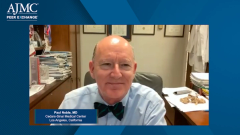
SSc-ILD Treatment Landscape and Clinical Trials
Dr Kristin Highland continues the treatment landscape discussion, focusing on systemic sclerosis ILD (SSc-ILD) and clinical trial data that studied therapy options for IPF, PF-ILD, and SSc-ILD.
Episodes in this series

Ryan Haumschild, PharmD, MS, MBA: Dr Highland, I want to transition and get your thoughts because one of the last areas that we haven’t really spoken about as in depth is the systemic sclerotic interstitial lung disease [ILD]. I’d love to hear your input on how you treat those patients. What is some of the comparing and contrasting of the different agents or treatment approaches that you’ve seen? Lastly, what is your individual practitioner approach to managing a patient in the frontline setting?
Kristin Highland, MD: Thank you. Patients with connective tissue disease, and scleroderma is really the connective tissue disease kind of prototype, we borrow those data for our other rheumatologic diseases. But the scleroderma community has been very organized at studying interstitial lung disease in scleroderma. The first point I’d like to make is that patients with scleroderma are generally a lot younger than a patient with idiopathic pulmonary fibrosis [IPF]. They have more potential years to live than a patient with IPF just based on our natural life expectancy. So even small reductions in forced vital capacity decline can add up over a lifetime. These patients really are looking for some sign of hope. With connective tissue diseases, in particular scleroderma, there are multiple pathways at play. There is the fibrotic pathway, there is the immunologic pathway, as well as a vascular pathway. Very often in scleroderma ILD, you have to target all 3 of those pathways. Our very first bit of hope was using immunosuppressive therapy.
Scleroderma Lung Study I studied oral cyclophosphamide, which is pretty toxic. In that study, after a year of oral cyclophosphamide, there was a very modest improvement in forced vital capacity in patients randomized to cyclophosphamide 2.5 mL, compared to a loss in forced vital capacity in patients randomized to placebo. Those patients were then followed for an additional year off of therapy, and all treatment benefit was gone by 24 months. That prompted Scleroderma Lung Study II because we know we cannot leave patients on cyclophosphamide indefinitely because of the toxicities of that drug. So Scleroderma Lung Study II was designed to be a superiority trial, where patients were randomized to 2 years of mycophenolate vs 1 year of oral cyclophosphamide, followed by 1 year of placebo. That was actually a negative study. What they showed was that patients randomized to cyclophosphamide performed similarly to patients randomized to mycophenolate. What was interesting about this study is that patients on cyclophosphamide did not lose their treatment benefit. In fact, both groups had improvement in forced vital capacity as well as improvement in their skin scores. Because of that, at least in the United States, mycophenolate then became the drug of choice for scleroderma-associated interstitial lung disease. Although it’s not FDA-approved, it’s become standard of care.
The next study was SENSCIS; that study randomized patients to nintedanib vs placebo. Patients were allowed to be on background mycophenolate or methotrexate. Only about 6% of patients were on methotrexate, and about 50% of patients were on background mycophenolate. But importantly, they had been on mycophenolate already for 6 months, so they were mycophenolate survivors. Then patients were randomized to nintedanib vs placebo. In that study, they showed that patients randomized to nintedanib had decreased decline in forced vital capacity compared to patients randomized to placebo. The treatment effect was on par with the IPF studies, but the absolute force vital capacity difference was less, because we know that patients with scleroderma have a shallower slope as a cohort of decline in the forced vital capacity, so the absolute value was 41 mL. But some of those patients we were able to follow out for 100 weeks and compare them to placebo, and at 100 weeks, that difference was more like 70 mL, so the curves diverged early and continued to diverge. Although that study was not designed to look at subgroup analysis, because 50% of the patients were on background mycophenolate, we were able to look at patients on combination therapy vs monotherapy vs not on immunosuppressive therapy and not on nintedanib. And patients on combination therapy did better from a forced vital capacity decline, numerically, than patients on nintedanib monotherapy, which was better than mycophenolate monotherapy, which was better than neither drug. So we have those data.
Then [there’s] the Scleroderma Lung Study III. We’re just waiting on the data, which should be coming out within the next year. That study is answering the question of whether we should be doing upfront combination therapy. In that study, patients are being randomized to upfront mycophenolate and pirfenidone vs mycophenolate and placebo. We will know something about that study within the year.
The latest kid on the block that got FDA approved is tocilizumab, and this is an interesting study, in that it was a skin study. The modified Rodnan skin score was the primary end point. The patients enrolled in this study had very early scleroderma, they had significant skin scores, and they had an inflammatory phenotype. Patients were randomized to tocilizumab vs placebo; they were not on any other immunosuppressive therapy. And so, there were a couple things that stood out to me from that study. No. 1 is that at baseline, these patients had their scleroderma less than 2 years, and although pulmonary function testing, the forced vital capacity, was above 80% and normal, 65% of those patients had evidence of interstitial lung disease on HRCT [high-resolution computed tomography]. So one of the lessons from that study is the importance of getting an HRCT in all patients with scleroderma, even if they have normal pulmonary function.
The primary end point of that study was negative, it didn’t change skin at all, and that’s probably because we don’t have a great skin end point in scleroderma. But a key secondary end point was forced vital capacity, and the study showed that there were fewer patients who had a significant decline in their forced vital capacity who were randomized to tocilizumab vs placebo. If you look at the 65% of patients who had evidence of interstitial lung disease, 24% of that cohort had a 10% drop in their forced vital capacity, vs only 8% who were randomized to tocilizumab, which is quite dramatic. If you look at the change in forced vital capacity between the 2 groups, it was over 100 mL, which is quite dramatic. And they showed evidence of improvement on quantitative fibrosis scores on HRCT. Based on those data, even though this is a study that had a negative primary end point, tocilizumab was FDA approved for the treatment of scleroderma interstitial lung disease. So we now have 2 FDA-approved therapies, nintedanib and tocilizumab, and standard of care is that most patients are on background mycophenolate.
For rituximab, the data on rituximab for scleroderma interstitial lung disease are a bit soft. Studies are ongoing, but the scleroderma community generally is using rituximab as rescue therapy for scleroderma ILD that does not respond to these other therapies. There are some data from the EUSTAR database, which is a very large scleroderma database in Europe, that suggest a treatment benefit from rituximab.
Ryan Haumschild, PharmD, MS, MBA: Dr Highland, you did a great job reviewing all those different trials. I love the data and how well you can speak to it because I think it’s important. When we think about the SENSCIS trial, INPULSIS, ASCEND, and focuSSced trials, it’s really important we look to those data to make some of these directionally correct decisions for these patients, and I think we need to stay on top of everything. That being said, and hearing the clinical data that were pronounced, I keep going back to some of the conversation with Dr Noble that was a little provocative, about moving the deck chairs, and how do these data really relate to the future of decision-making?
This transcript has been edited for clarity.
Newsletter
Stay ahead of policy, cost, and value—subscribe to AJMC for expert insights at the intersection of clinical care and health economics.





























































